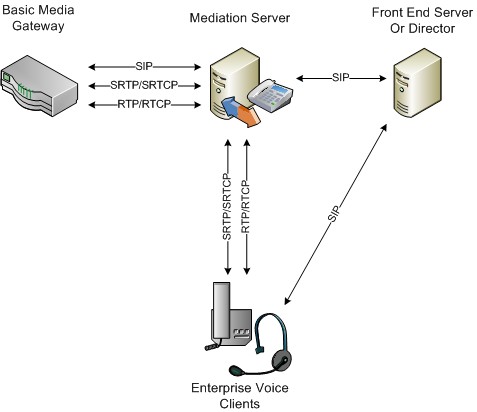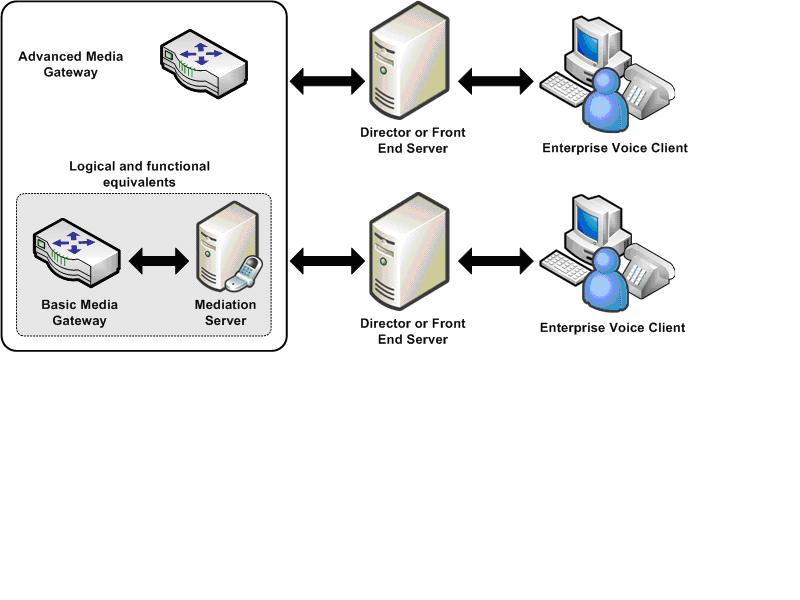The principal components you need in order to enable VoIP are as follows:
- Front End Server VoIP components
- PSTN Integration components
- Perimeter network VoIP components
 Front End Server VoIP
Components
Front End Server VoIP
Components
The principal VoIP components located on Front End Servers are as follows:
- Translation Service
- Inbound Routing component
- Outbound Routing component
- Exchange UM Routing component
Translation Service
The Translation Service is the server component that is responsible for translating a dialed number into the E.164 format or another format, according to the normalization rules that are defined by the administrator. The Translation Service can translate to formats other than E.164 if your organization uses a private numbering system or uses a gateway or PBX that does not support E.164.
Inbound Routing Component
The Inbound Routing component handles incoming calls largely according to preferences that are specified by users on their Enterprise Voice clients. For example, users specify whether unanswered calls are forwarded or simply logged for notification. If call forwarding is enabled, users can specify whether unanswered calls should be forwarded to another number or to a Microsoft Exchange 2007 Unified Messaging server that has been configured to provide call answering. The Inbound Routing component is installed by default on all Standard Edition servers and Front End Servers.
Outbound Routing Component
The Outbound Routing component routes calls to PBX or PSTN destinations. It applies call authorization rules to callers and determines the optimal media gateway for routing each call. The Outbound Routing component is installed by default on all Standard Edition servers and Front End Servers.
The routing logic that is used by the Outbound Routing component is in large measure configured by network or telephony administrators according to the requirements of their organizations.
Exchange UM Routing Component
The Exchange UM routing component handles routing between Office Communications Server and servers running Microsoft Exchange Unified Messaging (UM), to integrate Office Communications Server with Unified Messaging features. For details about these features, see Exchange Unified Messaging.
Other Front End Server Components Required for VoIP
Other components residing on the Office Communications Server 2007 R2 Front End Server or Director that provide essential support for VoIP, but are not themselves VoIP components, include the following:
-
User Services.Perform reverse number lookup on the target
phone number of each incoming call and match that number to the SIP
URI of the destination user. Using this information, the Inbound
Routing component distributes the call to that user’s registered
SIP endpoints. User Services is a core component on all Front End
Servers and Directors.
-
User Replicator.Extracts user phone numbers from Active
Directory Domain Services (AD DS) and writes them to
tables in the RTC database, where they are available to User
Services and Address Book Server. User Replicator is a core
component on all Front End Servers.
-
Address Book Server.Provides global address list information
from Active Directory Domain Services to Microsoft Office
Communicator clients. It also retrieves user and contact
information from the RTC database, writes the information to the
Address Book files, and then stores the files on a shared folder
where they are downloaded by Office Communicator clients. The
Address Book Server writes the information to the RTCAb database,
which is used by the Address Book Web Query service to respond to
user search queries from the 2007 R2 version of Communicator Mobile
for Windows Mobile. It optionally normalizes enterprise user phone
numbers that are written to the RTC database for the purpose of
provisioning user contacts in Office Communicator. The Address Book
Server is installed by default on all Front End Servers. The
Address Book Web Query service is installed by default on all Web
Components Servers.
 PSTN Integration
Components
PSTN Integration
Components
An enterprise-grade VoIP solution must provide for calls to and from the PSTN without any decline in quality of service. In addition, users should not be aware of the underlying technology when they place and receive calls. From the user's perspective, a call between the Enterprise Voice infrastructure and the PSTN should seem like just another SIP session.
For PSTN connections, you can either deploy a media gateway or use SIP trunking.
Media Gateways
Media gateways are third-party devices that translate
signaling and media between the Enterprise Voice infrastructure and
a PSTN or a PBX. For a list of partners who work with Microsoft to
provide devices that work with Office Communications Server, see
the Microsoft Unified Communications Partners Web site at
-
Basic Media Gateway.A basic media gateway requires the
assistance of an Office Communications Server server role, the
Mediation Server, to present a PSTN or PBX call to an Enterprise
Voice client connection. The Mediation Server also presents calls
from Enterprise Voice clients to the basic media gateway for
routing to the PSTN or PBX.
-
Advanced Media Gateway.An advanced media gateway combines
the functionality of a basic media gateway and that of the
Mediation Server. An advanced media gateway does not require a
separate Mediation Server to handle the signal and media
translation that is necessary to present a PSTN or PBX call as an
Enterprise Voice client connection.
-
Basic Hybrid Media Gateway.A basic hybrid media gateway
collocates a basic media gateway with a Mediation Server on a
single computer. The basic hybrid media gateway is available from
Microsoft partners for Office Communications Server 2007 R2. It
reduces installation and management overhead compared to deploying
a basic media gateway and Mediation Server on separate computers.
SIP Trunking
As an alternative to using media gateways, you can connect your Enterprise Voice solution to the PSTN by using SIP trunking. The Office Communications Server 2007 R2 SIP trunking capability enables the following scenarios:
- An enterprise user inside or outside the corporate firewall can
make a local or long-distance call specified by an E.164-compliant
number that is terminated on the PSTN as a service of the
corresponding service provider.
- Any PSTN subscriber can contact an enterprise user inside or
outside the corporate firewall by dialing a Direct Inward Dialing
(DID) number associated with that enterprise user.
The use of this deployment solution requires a SIP trunking service provider.
Mediation Server
The Mediation Server is a server role in Office Communications Server that provides signaling and media translation between the VoIP infrastructure and a basic media gateway or SIP trunking provider. A Mediation Server also links Office Communications Server with a PBX in both the departmental deployment and PBX integration topologies.
The Mediation Server is deployed as a stand-alone server inside the firewall. On the Office Communications Server side, Mediation Server listens on a single mutual TLS (MTLS) transport address. On the gateway side, Mediation Server listens on a single TCP or TLS transport address. TLS is recommended, but TCP is supported for gateways that do not support TLS.
The main functions of the Mediation Server are as follows:
- Encrypting and decrypting SRTP on the Office Communications
Server side
- Translating SIP over TCP (for gateways that do not support TLS)
to SIP over mutual TLS
- Translating media streams between Office Communications Server
and the media gateway
- Connecting clients that are outside the network to internal ICE
components, which enable media traversal of NAT and firewalls
- Acting as an intermediary for call flows that a gateway does
not support, such as calls from remote workers on an Enterprise
Voice client
- In deployments that include SIP trunking, working with the SIP
trunking service provider to provide PSTN support, which eliminates
the need for an IP-PSTN gateway
Figure 1 shows the signaling and media protocols that are used by the Mediation Server when communicating with a basic media gateway and the Enterprise Voice infrastructure.
Figure 1. Signaling and media protocols used by the Mediation Server

From the perspective of the Enterprise Voice infrastructure, the combination of basic media gateway and Mediation Server appear as a single entity. Together, they are the logical and functional equivalent of an advanced media gateway. When advanced media gateways become available, enterprises that deploy them no longer have any need for a dedicated Mediation Server. Meanwhile, the basic hybrid media gateway provides an interim solution for organizations that prefer to avoid deploying and managing a gateway and Mediation Server separately.
Note that if you are using TCP or RTP/RTCP (instead of SRTP or SRTCP) on the network between the media gateway and the Mediation Server, it is recommended that this network be a secure private network.
Figure 2 shows the logical equivalent of an advanced media gateway and the combination of a basic media gateway and Mediation Server.
Figure 2. Equivalent media gateway topologies

A typical organization supports multiple gateway–Mediation Server combinations, depending on the number of office locations, the number and distribution of Enterprise Voice users, network traffic, and performance requirements.
 Perimeter Network Configuration
for VoIP
Perimeter Network Configuration
for VoIP
Outside callers who use unified communications clients for individual or conference calls rely on Edge Servers for voice communication with coworkers.
On an Edge Server, the Access Edge service provides SIP signaling for calls from Office Communicator users who are outside your organization’s firewall. The A/V Edge service enables media traversal of NAT and firewalls. A caller who uses a UC client from outside the corporate firewall relies on the A/V Edge service for both individual and conference calls.
The A/V Authentication Service is collocated with, and provides authentication services for, the A/V Edge service. Outside users who attempt to connect to the A/V Edge service require an authentication token that is provided by the A/V Authentication Service before their calls can go through.







